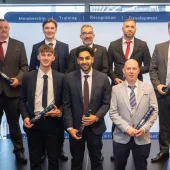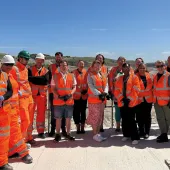Annual Conference 2008 Review

Meeting the green challenges – how sustainability is changing the outlook of the aggregates industry
Exciting and challenging times lie ahead for the quarrying industry, and this year’s high-profile Institute of Quarrying annual conference, hosted by the London & Home Counties branch at the Beaumont House Conference Centre, in Old Windsor, Berkshire, on 30 September, focused on issues associated with the sustainable development of the English capital.
Under the theme: ‘Developing London – Meeting the Green Challenges’, the 2008 conference proved a resounding success with more than 200 delegates attending what was a stimulating, informative and thoroughly enjoyable symposium.
With its high-tech conference facilities, Beaumont House provided the ideal environment for the event, and the London & Home Counties branch committee, with assistance from the Institute, QPA and the UK Green Building Council, should be congratulated for hosting a highly successful and thought-provoking programme for the conference.
It seems everyone has something to say about sustainability and the Annual Conference 2008 was no different, with a number of high-profile speakers contributing to the debate, including: Colin Jenkins, chief operating officer of Aggregate Industries’ UK Aggregate Products Division; Paul King, chief executive of the UK Green Building Council; and Dr Peter Bonfield, chief executive of BRE.
But perhaps the highlight of this year’s conference was special guest speaker Lord Sebastian Coe, former Olympic champion and now chair of the London 2012 Olympic Organising Committee, who gave an inspiring speech to the delegates about changing attitudes and making a connection with the younger generation.
The arrangement of the conference comprised two sessions: the morning session chaired by David Sharman, newly appointed president of The Institute of Quarrying; and the afternoon session chaired by Nigel Jackson, executive director of the QPA.
The proceedings began with a warm welcome by Paul Tallents, chairman of the London & Home Counties branch, who set the conference wheels in motion with a brief talk on sustainability and the environmental performance of the quarrying industry. Paul explained that the aggregates sector is conscious of the need to carry out its work in an environmentally considerate manner.
With key issues such as the effects of climate change and sustainable construction high on the quarrying industry’s agenda, he stressed that companies are now committed to minimizing the environmental impact of their operations. Indeed, some businesses are already making a positive impact on the environment through the restoration of sites and, in particular, through the creation of new wildlife habitats.
The aggregates sector clearly has a key role to play in helping the construction industry to operate in a more sustainable way. The planning of London 2012, the ambitious Thames Gateway project and the £4.5 billion M25 widening scheme are just some of the high-profile developments to have fallen under the green spotlight.
When morning session chair David Sharman took the stage, he echoed Paul’s comments on the industry’s role in meeting the green challenges. With the global economy currently in turmoil, brought about by the credit crisis and US housing slump, David remained upbeat about the future of both the building and quarrying industries.
He pointed that the development of London will continue, thanks to key building programmes such as the Olympics and the Crossrail scheme. As such, the wider quarrying industry will play a vital role in helping the construction sector meet its waste and sustainability targets.
Among the key challenges is the need to deliver construction projects with minimal waste and higher recycled content. The London Olympics, for example, is set to become the ‘greenest games in history’, with the organizers claiming that around 90% of the demolition materials will be reused or recycled, and at least 20% of materials used in the sports facilities and residential developments will derive from recycled sources.
London 2012 could well become a cutting-edge example of sustainability, but David warned that there would other challenges for quarry operators to overcome.
The first of the formal conference presentations was a discussion on the regeneration of brownfield sites by Paul Mathers, key account manager – brownfield, at WRAP.
With the Government pressing for brownfield site redevelopment, developers are now searching for cost-effective methods to make such land suitable for purpose. Paul highlighted how compost produced from organic waste can be used cost-effectively, as replacement topsoil, in the redevelopment of brownfield sites, addressing both cost-reduction and sustainability issues.
He also spoke about WRAP’s involvement in helping to develop the BSI Publicly Available Specification (PAS 100) for composted materials. Developers and landscape professionals can rest assured that compost achieving BSI PAS 100 is safe, reliable and sustainable.
WRAP is currently supporting a number of trailblazer projects to examine the financial and environmental benefits of specifying quality compost in brownfield redevelopments, including Polkemmet – a scheme that will use compost to help transform a former opencast coal mine into two championship golf courses, leisure facilities and residential housing.
Paul’s address was followed by Terry Marsh, head of the National Hydrological Monitoring Programme at the Centre for Ecology and Hydrology, who spoke about flood and drought risks in the Thames basin.
Terry discussed in detail the impact of climate change and the types of floods likely to occur in the UK, including fluvial flooding, which is often caused when the ground becomes saturated and, therefore, can no longer absorb water effectively. As a consequence, when rainfall is heavy and prolonged, a large amount of run-off reaches the rivers and eventually causes them to overtop their banks.
In the context of the presentation, Terry then asked: are fluvial floods a major threat on the river Thames? As scientific studies show, there have been substantial increases in temperature and variations in seasonal distribution of rainfall over the past 200 years.
Flood levels in the Thames basin, however, have not changed significantly, although the area remains vulnerable to the risk of flooding. Terry stressed the importance of understanding the flooding process better, and urged a similar stance towards droughts.
As the population increases in the South East, the demand for water is expected to rise, so it is imperative that drought mitigation measures are in place, which would maintain resources, reduce demand and improve the management of water.
After the mid-morning coffee break, Paul King began his address by explaining the reasons behind his switch from the World Wildlife Fund (as director of campaigns) to his present role as chief executive of UK Green Building Council.
The organization’s mission is to improve the sustainability of the built environment, by radically transforming the way it is planned, designed, constructed, maintained and operated. Excited by the challenge of creating more sustainable buildings, Paul praised the BedZed development, which, he believes, has set the benchmark for energy conservation and sustainability in buildings.
He also hailed Barratt Developments’ prototype zero-carbon home, and believes the house-building sector is heading in the right direction in meeting the Government’s target of ensuring all new homes are zero carbon by 2016.
Another key topic raised by Paul was the development of a Code for Sustainable Buildings, which aims to promote more sustainable building practices in the construction sector. The UK Green Building Council is currently leading a consultation process to assess what core sustainability standards should be contained within the new code of practice, how it should be developed and implemented, and how to ensure alignment with international rating tools.
During his pre-lunch address, Lord Coe inspired and entertained delegates with his account of winning the 2012 Olympic bid in Singapore three years ago and his time as an athlete, not least the rivalry he had with fellow Briton Steve Ovett.
The underlying message of Lord Coe’s presentation was the importance of reaching out and engaging with young people. When the official London Olympic bid video was played to delegates at the end of his address, the powerful message conveyed was to use the Olympic spirit to inspire young people around the world to life-changing decisions.
It was, without doubt, a profound moment during the symposium and showed that the London 2012 Organising Committee has a genuine commitment to putting youth at the heart of the Olympics.
After lunch, Rab Bennetts, director of architectural practice Bennetts Associates, spoke about how environmentally friendly building design can help achieve sustainability in the long term. The Government estimates that almost a fifth of all CO2 emissions in the UK are caused by non-residential buildings.
Developers, architects and contractors, therefore, need to collaborate and work closely together to reduce carbon emissions in new and existing buildings. Rab pointed out that sustainable building design could help cut CO2 emissions by as much as 70%, as he highlighted five basic principles for long-term sustainability in public buildings: efficiency; simplicity; robustness; adaptability; and low carbon emissions.
A fine example of innovative sustainable design for Rab is the Wessex Water operations centre, in Bath. Designed by Bennetts Associates, the building is largely naturally ventilated, rainwater is recycled, water is heated by solar power and heat-pump technology has been employed.
As the reduction in carbon emissions from buildings becomes increasingly necessary, Rab believes that renewable energy sources, such as natural lighting and passive cooling, will be actively encouraged by the Government to ensure all new homes and buildings are highly energy-efficient.
This means the measurement of energy usage – in the form of an energy rating or certification scheme – will be vitally important, as it will provide an incentive for building owners to improve the energy performance of their buildings.
Continuing the theme of reducing carbon emissions, Janet Kidner, head of sustainability at Lend Lease, gave an insight into how the need to operate more sustainably has helped the company fulfil its regulatory responsibilities and environmental aspirations.
Headquartered in Australia and a member of the Dow Jones Sustainability Indexes, Lend Lease are fully committed to sustainability and support the Government’s target of cutting carbon emissions from the built environment.
As a major player in the global construction industry, the company always looks to radically improve the energy performance of the new and existing buildings that they work on.
Reducing CO2 emissions from buildings has become a vital component of construction design, procurement policy and delivery – and, for Lend Lease, good energy management is fundamental to the construction and lifecycle of any building.
Janet gave examples of projects that demonstrate Lend Lease’s drive towards sustainable construction, including the refurbishment of their European headquarters, at 19 Hanover Square, in London’s West End.
The building is one of the first office refurbishments in London to receive a BREEAM ‘excellent’ rating, thanks to green features such as chilled-beam air-conditioning and motion-activated lighting.
Lend Lease are also developing the Athletes Village for London 2012 – a massive eco-friendly scheme that, according to Janet, will be built to sustainability principles.
As the construction industry takes a leap forward in operating in a more sustainable manner, Colin Jenkins, the next speaker on stage, spoke about the challenges of material supply in a low carbon economy.
He stressed the importance of the wider quarrying industry conserving its energy as much as possible to help reduce the carbon footprint of transporting materials to the end-user.
One of the biggest challenges facing the industry will be supplying aggregate products in an environmentally friendly way, eg using GPS to improve fleet utilization, adopting logistics management solutions for supply chain efficiency, teaching lorry drivers safe/fuel-efficient driving techniques etc.
Companies need to be aware of their energy usage by assessing the CO2 used in the production and distribution of their materials. Colin highlighted this by comparing the different modes of transporting building materials in terms of their environmental impact: road (4.24kg of CO2/tonne); rail (3kg of CO2/tonne); and sea (0.3kg of CO2/tonne).
As Aggregate Industries have demonstrated within their business, good sustainable practice is definitely the way forward for companies looking to achieve the environmental benefits associated with carbon management, biodiversity and community relations.
With the mandatory Code for Sustainable Homes enforced and the building of the Olympic Games infrastructure and venues well under way, there has never been a better time for the quarrying industry to go green.
The final speaker of the day, Peter Bonfield, focused on delivering sustainable construction by explaining BRE’s BREEAM scheme, which assesses the environmental performance of new and existing buildings.
He also touched on The Green Guide to Specification and a software tool called Envest, which allows architects to enter their designs and identify elements causing the most environmental impact at the initial design stage.
Having worked with the Olympic Delivery Authority (ODA) to help create the sustainable development strategy for the Olympics, Peter then talked about construction materials procurement for London 2012, from responsible sourcing and the use of secondary/recycled materials to reducing the environmental impact of transporting aggregates.
The day’s proceedings were concluded by Nigel Jackson, who summarized the stimulating issues raised during the conference. He also expressed his own opinions on change, collaboration and how resilient the wider quarrying industry can be, as it enters an uncertain and challenging future, with no current end in sight to the credit crunch and soaring energy costs.
The challenges presented by the Government’s sustainable construction agenda, however, will change the way the aggregates sector operates. Like the building industry, the quarry products sector has an equal responsibility to meet the green challenges, not just in London, but across the UK, as Nigel fittingly concluded: ‘We are essential and very much part of the solution.’
The Institute would like to acknowledge the generous support of Continental Crushing & Conveying and QMJ Publishing, main sponsors of the conference. Also, it is most grateful for the help provided by Aggregate Industries, CEMEX, Hanson, Lafarge Aggregates and Tarmac in sponsoring the VIP lunch.








